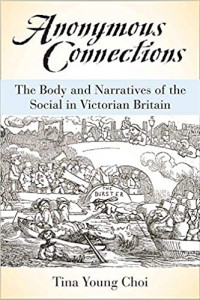Home » Faculty & Research » Our Research » Anonymous Connections: The Body and Narratives of the Social in Victorian Britain
Anonymous Connections: The Body and Narratives of the Social in Victorian Britain

Tina Choi
Year of Publication: 2016
Publisher website
Anonymous Connections asks how the Victorians understood the ethical, epistemological, and biological implications of social belonging and participation. Specifically, Tina Choi considers the ways nineteenth-century journalists, novelists, medical writers, and social reformers took advantage of spatial frames-of-reference in a social landscape transforming due to intense urbanization and expansion. New modes of transportation, shifting urban demographics, and the threat of epidemics emerged during this period as anonymous and involuntary forms of contact between unseen multitudes. While previous work on the early Victorian social body have tended to describe the nineteenth-century social sphere in static political and class terms, Choi’s work charts new critical terrain, redirecting attention to the productive—and unpredictable—spaces between individual bodies as well as to the new narrative forms that emerged to represent them. Anonymous Connections makes a significant contribution to scholarship on nineteenth-century literature and British cultural and medical history while offering a timely examination of the historical forebears to modern concerns about the cultural and political impact of globalization.
“Choi’s work makes a unique and original point: complex, multi-plot Victorian narratives and notions of the social order fed and were fed by one another. . . . This book will be an important one for scholars of Victorian literature and culture.”
—Laura Otis, Emory University
—Laura Otis, Emory University
“In this astute interdisciplinary study, Tina Choi examines new understandings of material connections between bodies—miasmas, microbes, body parts, waste—across geographical distances and social classes in the Victorian period. Anonymous Connections moves between literary and scientific texts to forcefully demonstrate that transformed conceptions of bodily intimacies also transformed conceptions of social relations. Surprisingly, such connections were not necessarily conceived of as threatening, but also inspired positive ideas of social cohesion. One of the great virtues of Choi’s study is that it persuasively shows that the scientific and medical theories she discusses have important implications for plot and narrative form in the nineteenth-century novel.”
—Suzy Anger, University of British Columbia
—Suzy Anger, University of British Columbia
